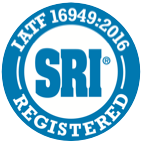Density Considerations for PM Components
Powdered metal (PM) components are excellent, cost-effective alternatives to machining metal components from wrought steel, but one difference between wrought steel and powder metal is density. The typical density range for the PM process is 85% to 93% (6.6 g/cm3 to 7.3 g/cm3) in structural applications, 75% to 87% (5.8 g/cm3 to 6.8 g/cm3) in bearing applications, while typical wrought steel material is 100% (7.8 g/cm3). But with the PM process, other aspects are introduced. Density and chemistry can both be adjusted, tailoring part characteristics and resulting performance. Choosing the appropriate density for an application allows our customers to “trade” the cost of a fully dense steel component for a more economical PM component. In this article we will discuss several factors that impact density; from material selection to secondary operations, and many aspects in between.
Raw Material
Atlas Pressed Metals works with our customers to understand the component’s application and requirements, because in our experience, a cooperative approach in material selection is best. We will strive for a cost effective material solution that still meets all performance requirements.
Let’s take a look at a few different powder mixes and discuss the impact powder selection has on density. Copper alloyed steels (FC) have small amounts of copper and frequently graphite is added to the mix, creating a strong material at a reasonable price. The iron copper family of alloys can yield densities up to 90% dense (7.0 g/cm3) with conventional press and sinter processing. Iron Nickel (FN), Diffusion alloyed (FD) and Pre-alloyed (FL) materials may be pressed over the 90% dense (7.0 g/cm3) level up to 93% dense (7.3 g/cm3) using conventional pressing methods. Selecting a material that corresponds to the needs of the application is a great start.
Compaction
The compaction process is the first step in creating a PM component. During compaction the raw material (a fine particulate metal powder) is fed into a tool cavity and pressed to near finished geometry. Because the density of the compacted part will be higher than the density of the powder, the powder will fill a volume that is approximately twice the volume of the compacted part.

Sintering
After a part is compacted, the next operation is typically sintering. During the sintering process, powder particles bond to one another. The particles do not actually reach melting temperature during sintering, but rather ‘neck’ to one another at elevated temperatures, as depicted below.

How well the particles bond to each other during sintering depends on the temperature and the amount of time spent at temperature. Higher temperatures and longer sintering time mean the particles will form better bonds.
A conventional sintering furnace is capable of reaching up to 1150°C (2100˚F). The properties of most materials listed in material standards like the MPIF/ASTM/DIN/JIS/SAE are based on a conventional sinter, 1120°C (2050°F) for iron based materials, and approximately 815°C (1500°F) for copper based materials. There are opportunities to improve densities during the sintering operation by increasing temperatures to 1260˚C (2300°F) or beyond. As the part is heated the size of the part is reduced along with the porosity size. At Atlas Pressed Metals, we have seen as much as an 8% increase in density, meaning a 90% (7.0 g/cm3) molded density shrinks to a 97% (7.55 g/cm3) density, as shown in the above image. Reaching such temperatures requires a “high temp” sintering furnace, which impacts the cost to manufacturing a component since sintering is often the most expensive part of the PM manufacturing process.
Infiltration while Sintering
Copper infiltration is a different way to increase density in PM components. Like the double press double sinter noted above, this process is being replaced by some other technological advancements, but is still used to increase density and mechanical performance.
Copper infiltration can yield densities up to 93% dense (7.3 g/cm3) and improving strength. In this process, a predetermined amount of copper is assembled onto a compacted component prior to sintering. During the sintering operation, the copper melts and infiltrates the component. The popularity of this process is declining because of the cost of copper and the required assembly. Similar results can now be achieved with modern powder alloys and compaction techniques.
Sizing
A secondary operation called sizing or restriking is an optional process that may be employed after sintering to increase density, among other things. Sizing is an operation that is not commonly employed as a means of strictly increasing density. It is a process that is more commonly used for post-sinter dimensional control, with increased density being a second advantage of the sizing process.
Conclusion
In this article we discussed many options that affect densification. There are many ways of creating a PM component that will meet your needs, however, by consulting with Atlas Pressed Metals early in your design process the component can be manufactured in the most cost effective manner, resulting in parts that are better for the end user, the assembler, and the manufacturer. If you have any additional questions or would like to discuss density in more detail, contact us today!
contact information
Mailing Address
125 Tom Mix Dr.
P.O. Box P
DuBois, PA 15801
USA
Fax(814) 371-4182
testimonials
Atlas Pressed Metals has been a long time supplier to our company. They are reliable, responsive to quotes, and always have met our deadlines. Their communication is thorough and we have been most happy with our sales representative. We feel strongly that we should treat our customers and suppliers as we would like to be treated, and Atlas seems similar in this regard. It is a pleasure to do business with them.”
.png)



